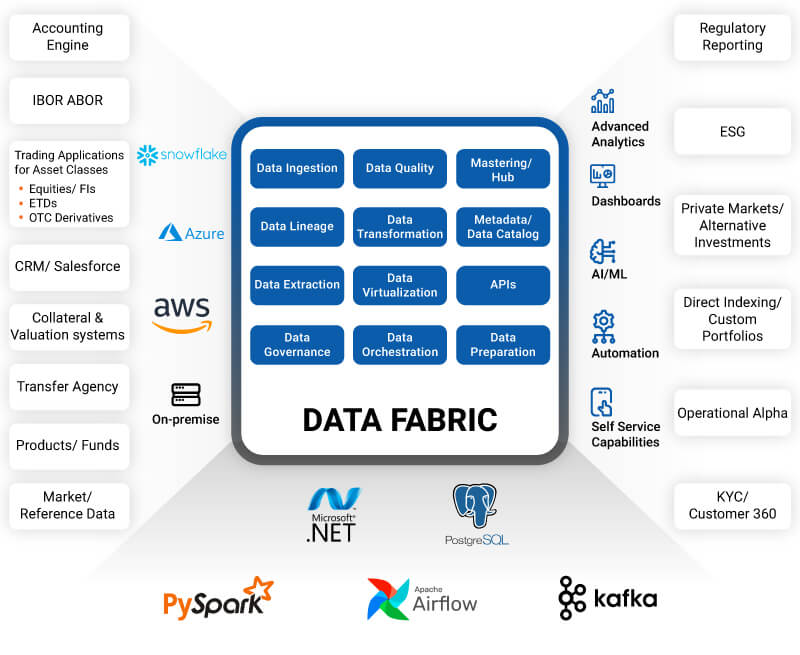Financial Institutions and data always go hand-in-hand. The business units consume data to generate revenue and create meaningful insights, but data that is siloed, unreliable or in large quantities just adds to risk of business potential, frustration and no value or insights can be attained from such data. With increased regulations in capital markets the margins are under pressure and the need for cost savings has become important for FIs.
Reimagining data management in capital markets has become vital to facilitate better financial decisions, and with the access to mine different forms of data (structured and unstructured), organizations are looking for modern data integration services that are AI-enabled.
Data Fabric is one such architecture gaining traction by providing a robust solution to data management challenges which include high cost, real-time metadata-driven sharing, and multiple cloud environments. It unlocks business value by simplifying data access and facilitating the right data at the right time, helping drive better decision-making across the organization. It enables data management regardless of the applications, platforms, and locations where the data is stored.
In simpler terms, imagine data fabric as a cloth spread across all geographies of the organization. Now, the user can be at any given place in this fabric with the liberty to access data at any location, with no constraints, in real-time.
Why Use Data Fabric for Financial Services
With trends in capital markets such as multi-asset trading, private markets portfolio, sustainable investing and stringer regulations in place, simplified data architecture is the need of the hour. A research by Oliver Wyman and Morgan Stanley found that the benefits from having clean, consistent and automated data management could be a two to four percent reduction of infrastructure and control costs. Data fabric is a data management architecture, offering centralized access and a single unified view of data across the firm.
Data fabric enables faster extraction of insights and the governance embedded helps in data security which is of importance for a highly regulated industry like financial services.
With centralized access to data, data security and embedded governance, customer experience is improved through personalized offerings and self-service capabilities based on the various data collected from them. Data fabric architecture benefits the companies by helping them in designing informed and comprehensive solutions and by providing them personalized financial solutions based on their financial history and goals.
Managing Data Challenges: The Road Ahead
Data fabric architecture helps in avoiding the creation of additional data silos without effecting the business continuity, which is especially important as financial firms increasingly embrace cloud and act as a bridge between legacy and modern systems. Financial institutions have data across different systems – accounting engine, market data, client data and various users – customers, fund managers, and business system analysts. Data fabric architecture facilitates the end-to-end integration of these data silos present across various cloud environments.
Furthermore, analytics capabilities can be embedded directly into the data fabric architecture like NLP (Natural Language Processing), Machine Learning and AI (Artificial Intelligence), Data exploration, etc.
Data Fabric Architecture:

Benefits of Data Fabric Architecture
Data fabric works best for organizations that have geographic diversity with multiple data sources and face complex data challenges. More than a network, data is leveraged for insights, and to help organizations maximize the potential value of data. It also minimizes data inconsistency and risks associated with compliance, eventually improving data quality.
Data fabric helps organizations to emerge as digital leaders by:
- Offering a single environment – eliminating data silos
- Enabling unified and simplified data management by removing the usage of multiple tools and providing access to accurate data
- Providing great scalability to adapt large volumes of data and data sources
- Delivering faster migration between different environments by eliminating dependency on legacy solutions and infrastructure
- Easing the addition of new data sources and technologies to the Data Fabric without changing existing data connections
The 5 Key Pillars of Data Fabric
- The ability to identify, integrate, segment, and share large volumes and varied forms of metadata (technical, runtime, business, social)
- The ability to perform analytics over connected metadata in a knowledge graph (Analyze and convert passive metadata to active metadata)
- The ability to use AI/ML algorithms to deliver “just-in-time” data management infrastructure and processing maps for data integration use cases
- A strong data integration backbone – Without a strong integration backbone that can support different styles, a Data Fabric will fail to scale beyond traditional data integration use cases
- The ability to automate data orchestration
With a singular data fabric overlaid nearly atop the various data repositories, a company will bring some aspect of unified management to the disparate data sources and downstream consumers; however, it’s worth noting that only the management is integrated, not the actual storage, that remains distributed.
Amaze® for Capital Markets – The Game Changer
Hexaware’s Amaze® for capital markets is a low-code no-code data management tool. A financial services cloud solution, it helps solve the problems associated with legacy solutions and generate insights to customers for better visibility and to accelerate business innovation.
Amaze® for Capital Markets is a cloud native NextGen data management platform that leverages intelligent automation technologies to deliver self-service capabilities, superior end-user experience and operational efficiencies.
Conclusion
Financial institutions from banks, insurance companies, asset managers to brokers and custodians have always been conscious about their data and how to utilize every data point they can and have access to. With clients demanding better user experience, self-service and increased access to analytics, the need for free data from disparate sources is required. At the center of this modern data management, the adoption of innovative data architectures like Data Fabric is gaining traction and providing a competitive edge in modernizing data management and integration.
Maximize the power of your data by aligning data processes across your organization and augment your data integration ecosystem. Being an end-to-end management solution, organizations with diversified geos will have to consider existing and new data points to optimize underperforming legacy systems. Employ a Data Fabric to your enterprise to see a transformative change in data handling and data consumption.
References:
https://www.datanami.com/2021/10/25/data-mesh-vs-data-fabric-understanding-the-differences/
https://www.ibm.com/topics/data-fabric
https://www.gartner.com/smarterwithgartner/data-fabric-architecture-is-key-to-modernizing-data-management-and-integration
https://www.bobsguide.com/articles/is-smart-data-fabric-the-approach-financial-institutions-have-been-dreaming-about/



















